When my commentary on Khmer food slows down, I’m usually out of Cambodia and this time it was in the only Indochinese country described as sleepier than Cambodia: Lao PDR. Thanks to having some friends in Vientiane, I did get to eat a fairly representative sample of the local delicacies.
Sticky rice (kao neaw) is both self explanatory and ubiquitous as the national staple. The process to make it seems complex enough that it involves a fire, a purpose-built basket and constant attention; akin to the early years of ballooning but with slightly less chance of setting yourself on fire and crashing back to earth in a ball of fiery death. It might give the rice a stickier and more fibrous texture, but I think that I would rarely have the time on my hands that it takes to prepare.
In more proof that if you can grind up an animal, you can eat it, laap, the ever-popular minced meat salad, is available in every imaginable meat. I managed to fit in laap in five different ground animal flavours but none in the evil non-meat equivalent, tofu laap. Whenever I attempt to build myself some laap, I can never balance the chili/lime/galangal/fish sauce properly, and so every Laotian laap I ate fills me with both shame and meaty deliciousness. I heard tales of iguana laap but had no success in finding a local lizard grinder or procuring myself an iguana. The local Laos green papaya salad (Tam Mak Hung) is spicier than our Khmer variety and there also seems to be a marked preference to go a little crazy on the fish sauce.
For me, the two main drawcards of Luang Prabang seemed to be the town’s World Heritage listing and a regionally famous snack made from dried sheets of river algae that comes with a buffalo rind and chili sambal.
From the early part of the dry season, northern Laotians harvest river algae (kai) that they then proceed to sun-dry before pressing into flat sheets with sesame seeds and local vegies. The resulting algae paper (kaipen) tastes like the kelp wrapping from a sushi roll, deep-fried; and the traditional accompanying paste made from ground chili and buffalo rind tasted much like someone had set a fistful of large, sliced rubberbands alight in my mouth with roughly the same texture. Before coming to Laos, I was told that it was “a great snack to eat with Beer Lao” which I should have translated as “a great snack to eat when incomprehensibly drunk”. The buffalo isn’t all bad, as Laotians also make an excellent buffalo sausage.
As for restaurants:
Moon The Night – Not a suggestion for an lewd gesture aimed at the evening but a local restaurant overlooking the Mekong, upstream from the main strip. Like every good local Indochinese restaurant, it blares local pop music at earbleed levels. Their duck laap was excellent although padded out with various offal. Not that there is anything wrong with that.
The strip of local restaurants that line the Mekong roughly opposite the Lane Xang Hotel seem to vary in quality with the weather, but are good for a cheap sticky rice and laap fix.
My brother, who worked in Laos for a while recommended me…
KhuVieng Fried Chicked (KFC). If this doesn’t make a phnomenon write-up, the universe is in a state of imbalance. The crispiness of the chicken puts the Colonel to shame, yet the establishment is somehow notably absent from my edition of the LP. It’s near a large tree about three-quarters of the way down Khu Vieng street if you’re heading towards the Australia Club. It’s on the right and easy to miss, so take your time.
…but I couldn’t find it in several very slow passes on my hired Suzuki Viva. However, just off Khu Vieng is a great spring roll store aptly named The Spring Roll Store. Their spring rolls aren’t bad but the mystery rice salad that accompanies the rolls is excellent. There are two ingredients in it that I can’t identify and I’ll mail a can of your choice of Klang to anyone who can speak enough Laotian to find out. If you’re in Phnom Penh, I’ll drop it by your house in person. One of the components is deep-fried (a spring roll part? Deep-fried leftovers?) and the other is a vegetable (Green papaya? Mango? Cucumber?).
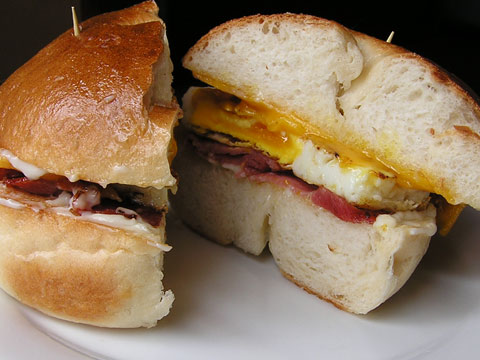
JoMa Café – So barang that it physically hurts but that didn’t stop me from visiting both the Vientiane and Luang Prabang outlet for Bagel Eggers (17000 kip, above; no relation to David) and good espresso with choice of local or imported beans. I’m on holiday. Your Cambodian breakfast bobor is no match for the true might of a bacon sarnie and decent coffee. Location: On Sethathirath Road in VT; Near cnr of Sisavangvong Rd and Setthatihilat Rd in LP

Luang Prabang Night Market – At the end of the night market (opposite the daytime Handicraft Market), a small alleyway becomes a Laotian street food emporium. Despite being on the way to dinner elsewhere, I did my best to pick up a selection of deep-fried things (a few balls of deep-fried sticky rice coating a nugget of banana, 5000kip for a hefty bagful; spring rolls, 2000kip worth) to eat en route. There were some good sized racks of pork that I would have had a crack at, but thought it might offend my fellow diners if I rocked up with half a side of a pig.
The Apsara – Herbert Ypma’s Hip Hotels calls this place “the most chic hotel in Luang Prabang” which I only know because they had two different copies of Ypma’s trendspotting tome displayed on their coffee table. Seems to be the only modern place in town that recognises Luang Prabang’s period of suzerainty under Jayavaraman VII, at least in name although no Cambodian food from that era on their “Asian fusion” menu. Their $6 steak frites (below) was a cheap, unidentifiable cut but at that price I would be happy to gnaw on a another strip of buffalo. I take my iron where I can get it. Location: Ban Wat Sene, Thanon Kingkitsarath, Luang Prabang.
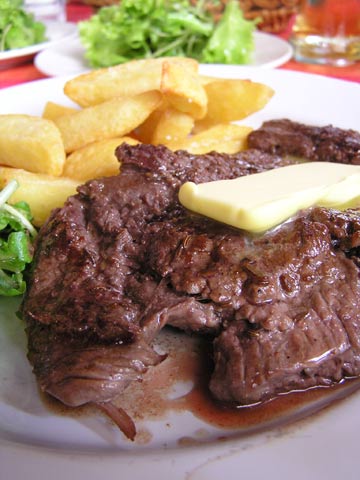
Are there any Laos food blogs out there? Comments are open.
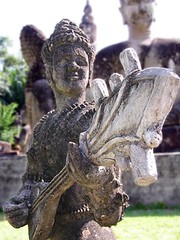
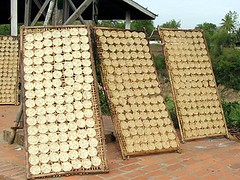
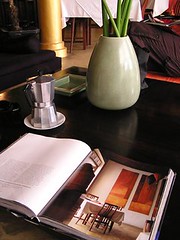
If you’re ever back in Vientiane, I would recommend checking out the Golden Horse, on the waterfront about 1.5km south of the main strip. The food is good (seafood), but the real star is Kevin, the American owner who, according to him, went to Laos on a mission to recover remains of US soldiers, but would up marrying a Lao and staying. He’s the sort of character Graham Greene would have written about.
BTW, tried the coffee at the Mondulkiri Cafe yet?
Nicely written, as always.
I have some trips to Lao coming up later in the year and I am looking forward to it now.
Lord Playboy
A Lao foodblog is sorely needed to complete the set, IMO.
After a little bit of searching, there does seem to be a few Lao expats writing food blogs: http://thai-laos-food.blogspot.com who is logging recipes in Canada; and http://laocook.com/ which is from Spain, doing upmarket Lao food.
Probably of interest to you, pieman, Lao Cook is testing che made with champagne jelly, which I’m sure will be waiting for you on the streets of HCMC next time you’re back.
Howdy,
I’m unfortunately not a Lao blogger, but I do have several mentions on the food of that country at my blog here http://realthai.blogspot.com/2006/04/real-lao.html, here http://realthai.blogspot.com/2006/05/food-of-luang-prabang.html, and here http://realthai.blogspot.com/2005/12/worlds-greatest-sandwich.html, as well as elsewhere that I may have forgotten… And I hope to include more, as I find the food in Laos, especially in Luang Prabang, wonderful.
Austin
Phil,
Excellent write-up on Laos. Checked out those Lao food blogs you found. They were a tad disappointing – uninspired, humourless, overly Thai influenced and lacking your commitment to street food.
I struggled to get past the first’s sanctimonious introduction “The reason for my blog is to preserve the authenticity of the Thai and Lao food” (yeah Toronto is definitely the best place to do that).
The second lost me when it referred to “deconstructing a dish” and includes an “authentic” recipe using uncooked prawns. As a resident of landlocked, generally dirt poor Laos I can safely say if you eat uncooked prawns here you will die.
The last is written with annoying tone wonderment. It also gives credence to the oxymoronic, self-serving claim of one restaurateur that his is “the only restaurant in Luang Prabang that serves authentic local food”. Finally, it bizarrely and insultingly uses Mick Jagger as a barometer for culinary modernity. It is unsurprising that this reprint of a rejected article failed to find a publisher.
Perhaps you will just have to become a regular visitor to Laos.
Jam-ez says….” an “authentic†recipe using uncooked prawns. As a resident of landlocked, generally dirt poor Laos I can safely say if you eat uncooked prawns here you will die. ”
Never had Sao Noi Disco? The prawns are raw and alive, i have eaten them, and i am not dead!
I like both the Thai Lao food blog and laocook for a number of reasons. I try to look past any lapses in style and just appreciate the blogs for what they are. They are blogs by Lao people writing about Lao food.
Thai Lao is a fusion of the two styles of cooking and in real life there is also a lot of cross pollination amongst the styles, heavy Chinese and Vietnamese influences also. The videos are great in that you can see what it is she is actually doing.
Lao cook is obviously influenced by his work as a chef, and although many of the recipes are presented beautifully on clean plates with artful vegetables surrounding etc etc the food is often representative and to be found in many kitchens.
I’ve never heard of a blog reviewing restaurants. Myself, I like Lao food but don’t like restaurants as a rule. In Laos I seldom eat at anything fancier than street food, keeps me from being let down. Indeed most Laotians don’t eat in restaurants. Having returned to the states recently I think going to Lao restaurants won’t be a problem in that there aren’t any.
I’ve blogged about lao food on occasion, click on food in the section called labels on the right hand side.
http://laobumpkin.blogspot.com/
The raw prawns are great. If I worried about anything it would be the liver flukes in the uncooked plah dek that’s in the tom mak kune.
Sun Saap
Somchai